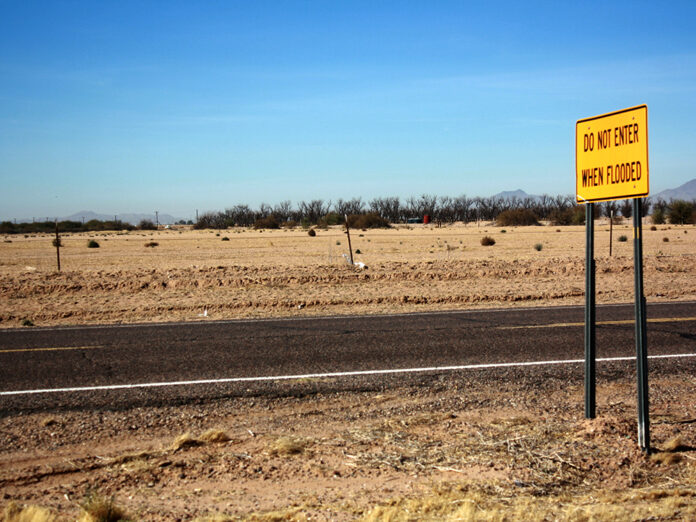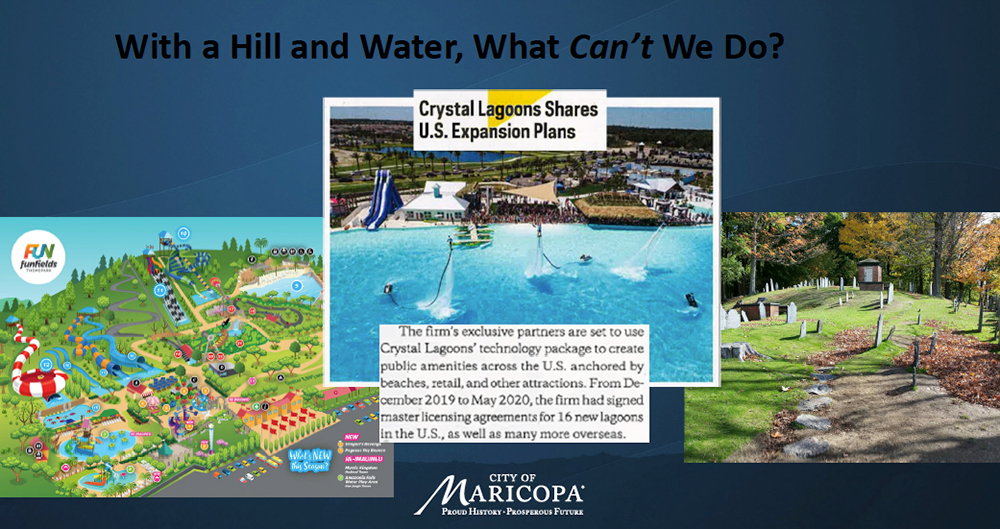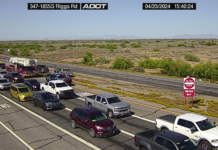
The North Santa Cruz Wash floodplain is a significant impediment to economic development on the east side of Maricopa.
But a mitigation project to remove about 11 square miles of land surrounding the city complex on White and Parker Road from the floodplain is underway. Completing the project, with channels, levees, a 110-acre retention pond and other infrastructure, will cost about $60 million, according to city manager Rick Horst.
The remediation project would serve to replace the mile-wide-or-wider wash with a 300-foot-wide, deep channel, city officials have said.
During a recent annual Future Planning session with city council, Horst outlined the economic benefit of the project, which would divert waters from the flood plain and allow for its development. The return on the city’s investment could start coming in quickly, he said.
“I think we are anywhere between today’s date to 18 months from now from having it completed,” he said, noting the flood mitigation project would allow for the development of about $1.8 billion in assessable value, based on current building patterns.
“Of course, that will pay for police officers and firefighters and parks and libraries and all those things we need to do,” he said. “And frankly, I think that number will be higher because our pattern has just been single family homes and now we’re going to have more retail and office and other elements in that mix.”
Horst said the $60 million price tag is certainly hefty – but well worth the investment. He noted the city spent more than $50 million to open Copper Sky Regional Park, and it did not offer anywhere near the opportunity for revenue capture as the Santa Cruz Wash area. The source of the revenue that could be generated there is one of the best things about the project, he said.
“Remember it’s not all the taxpayers who are going to pay for it,” he said. “It will be the landlords and developers and builders and people who buy at the end of the day, and probably, virtually none of it will go to our existing taxpayers to pay for. This will be the people benefiting from new development.”
He said the hardest thing would not be putting the bond together, it would be trying to figure out the financing. With the number of developers expected to want a piece of a project that large, splitting up the financial aspect of the project will require a deft touch, Horst said.
In the coming months, the City will begin work on putting together that financing package.

HUGE DIRT MOUND, HUGE OPPORTUNITY
While the project will free some residents from paying the flood insurance required now, there is much greater opportunity, according to Horst. So, what type of development might occur in those 11 square miles removed from the flood plain?
Plans envision a network of hiking or walking trails, possibly an arts and theater district and plenty of open space. The 110-acre retention pond represents a big hole in the ground and the ideas for what to do with the excavated dirt show the creativity of Horst and his staff.
“One of the city’s big expenses would be not only digging the dirt out of a hole that size, but hauling the dirt away,” Horst said. “Well, maybe we build a hill. With a hill and water what can we do? Well, how about a water theme park? We could use the natural fill which could be the home to large water slides, dirt bike rides, or mountain bikes, whatever. And if you want to fund this, if you’re doing a $60 million bond, what’s another two or three million dollars for heaven’s sake? Throw it in there and let’s figure out how to use this big hill.
“Again, let’s look at opportunities in the present-day situations before us,” he continued. “If we save $5 million on hauling the dirt away could we spend $5 million to leave the area with something like this? We’re not spending any more money; we’re just using it more effectively.”
Once the city knows exactly how much dirt will come out of the hole, and how high a hill that dirt will build, he thinks the people of Maricopa might have some good ideas about what to do with it. “We’re not asking you to design it or figure out how to pay for it or do any of these pet projects. We’re just asking for your ideas – what do you envision?”
He did rule out one possible use, however.
“A ski slope probably won’t happen,” he joked.

![MHS G.O.A.T. a ‘rookie sleeper’ in NFL draft Arizona Wildcats wide receiver Jacob Cowing speaks to the press after a practice Aug. 11, 2023. [Bryan Mordt]](https://www.inmaricopa.com/wp-content/uploads/2024/04/cowing-overlay-3-218x150.png)




![Maricopa’s ‘TikTok Rizz Party,’ explained One of several flyers for a "TikTok rizz party" is taped to a door in the Maricopa Business Center along Honeycutt Road on April 23, 2024. [Monica D. Spencer]](https://www.inmaricopa.com/wp-content/uploads/2024/04/spencer-042324-tiktok-rizz-party-flyer-web-218x150.jpg)





![Alleged car thief released without charges Phoenix police stop a stolen vehicle on April 20, 2024. [Facebook]](https://www.inmaricopa.com/wp-content/uploads/2024/04/IMG_5040-218x150.jpg)

![MHS G.O.A.T. a ‘rookie sleeper’ in NFL draft Arizona Wildcats wide receiver Jacob Cowing speaks to the press after a practice Aug. 11, 2023. [Bryan Mordt]](https://www.inmaricopa.com/wp-content/uploads/2024/04/cowing-overlay-3-100x70.png)


